Dignity denied: Life in the settlement area of Hebron city
Deterioration of situation in the year after the withdrawal of international observers
In September 2018, following an attack by Israeli settlers, Suhad and Ahmad concluded that their family could no longer stay in Tel Rumeida, located in the Israeli-controlled area of Hebron city (H2). Suhad and their three children left for another part of the city, while Ahmad has continued living in the same home, from where he runs his business. “Buying a new apartment was a huge economic effort, but I had to think of the welfare of my children.”.
Some 33,000 Palestinians and 700 Israeli settlers live in the H2 of Hebron city. In 2015, following a wave of Palestinian (mainly stabbing) attacks, the Israeli authorities declared an area encompassing four settlement compounds as a ‘closed military zone’, where access to Palestinians not registered as residents has been restricted.[2] Vehicular, and in some cases pedestrian, access to areas surrounding the closed zone has also been restricted. It is estimated that about 7,000 Palestinians, 20 per cent of the H2 population, reside in these access-restricted areas.
The living conditions of Palestinians in H2, particularly (but not only) in the ‘closed military zone’, deteriorated during 2019, following an increase in settler attacks and harassment, as well as in friction and clashes with Israeli forces, affecting primarily school-children. A number of measures have been undertaken by the Israeli authorities to ease access and improve living conditions in H2 during the year. However, Palestinian movement remains extremely constrained and unpredictable.
This largely coincided with the departure of the 65 international monitors of the Temporary International Presence in Hebron (TIPH) on 31 January 2019, following Israel’s unilateral termination of its mandate after 22 years. TIPH was the only organization documenting incidents and providing a protective presence that was authorized to access any part of the city on foot and by vehicle, and it had direct channels to address urgent incidents and concerns with the relevant authorities. The departure of TIPH has placed increasing pressure on the other organizations providing a protective presence in H2, which forced them to withdraw or to scale back.
In response, humanitarian and human rights partners have put together an action plan aimed at mitigating the continuing deterioration in the situation. Its implementation is contingent on the mobilization of the necessary resources, estimated at some US$ 7 million.
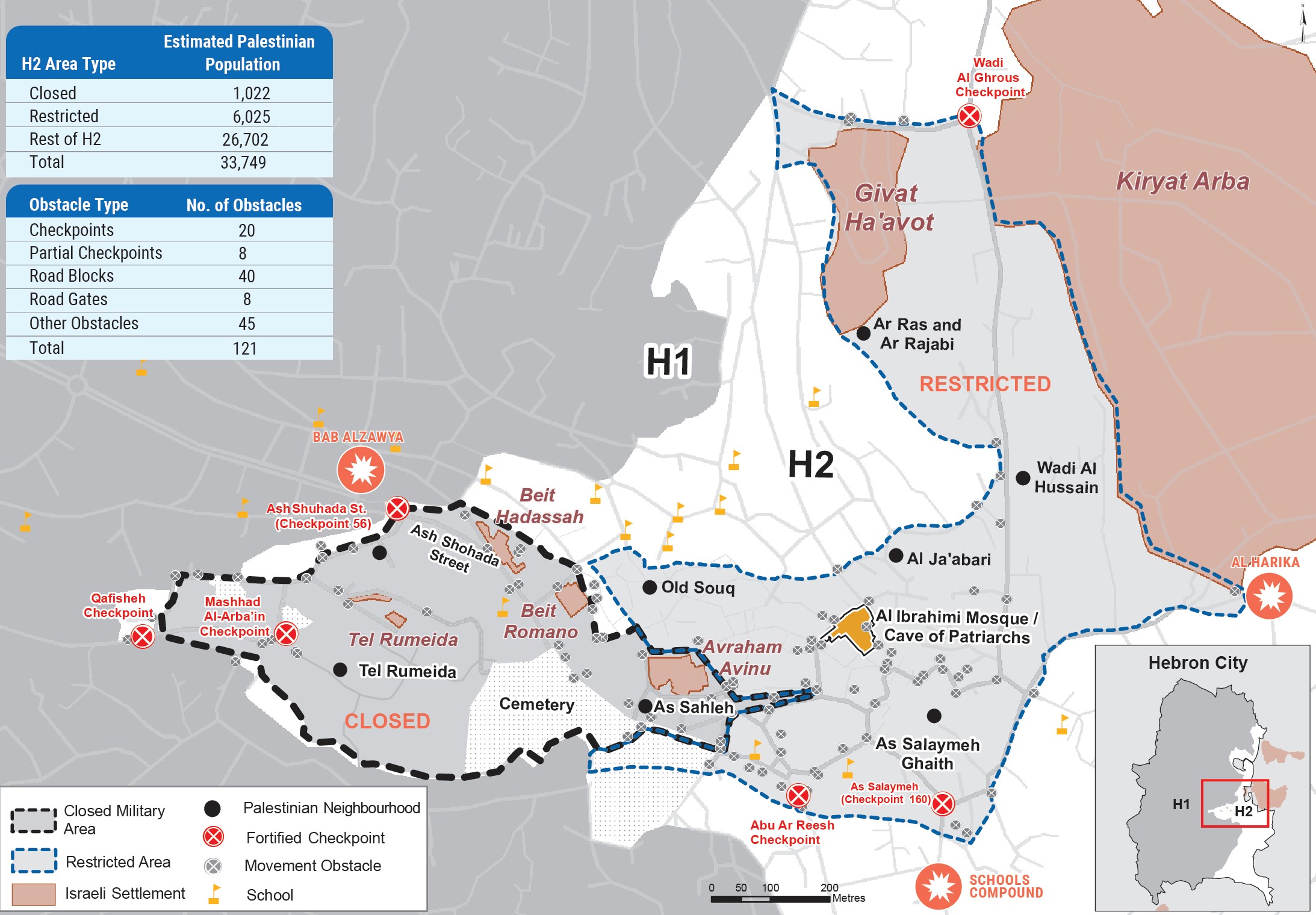
Increased violence and harassment by settlers
In 2019, OCHA recorded 47 attacks by Israeli settlers against Palestinians in the H2 area of Hebron, resulting in 52 injuries, including 16 children, as well as damage to Palestinian homes, schools, vehicles, trees, crops and other property.[3] The number of incidents recorded in 2019 doubled compared to 2018 and tripled compared to 2017 (see chart).
Although many of these attacks were perpetrated by Israeli settlers carrying weapons, all of the attacks recorded in 2019 resulted from other forms of physical assault, including beatings, throwing of stones and bottles, and pepper-spraying, among others. The UN Office of the High Commissioner for Human Rights (OHCHR) has also documented several cases where threats and intimidation were of extreme severity, including direct and repeated death-threats.
During 2019, OCHA did not record any Palestinian attack against Israeli settlers in H2 that resulted in either injury or property damage.
Incidents of settler violence against Palestinians
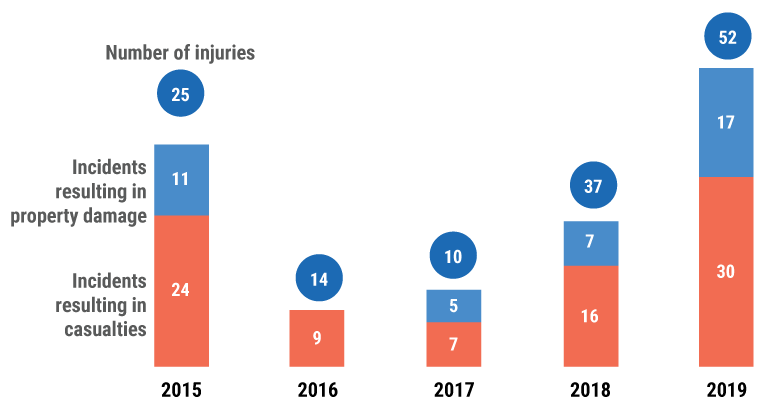
One of the peaks in settler violence during 2019 was recorded on 22 and 23 November, when thousands of settlers and other Israelis visited Hebron on the occasion of a Jewish religious celebration (‘Parashat Chayei Sara’).[4] At least six attacks resulting in injury to 24 Palestinians, including seven children, were recorded in those two days alone. In one incident on 23 November, a young child was injured in the head, after a group of settlers threw stones and bottles at his house. His evacuation to the hospital was delayed by more than 20 minutes due to the ongoing assault on the house and the Palestinians who carried him to the nearest checkpoint, where an ambulance was waiting, were also attacked by settlers with pepper spray.
Of additional concern, several of the attacks recorded in 2019, including some that took place during the 22-23 November events, occurred in the presence of Israeli soldiers, who either took no action to prevent the attacks or to protect the Palestinians, or actively participated in the harassment and violence.
According to Ahmad (see above mentioned case), in September 2018, a group of settlers attacked himself, his wife and nephew, as they were leaving their home in Tel Rumeida. “I have no idea what triggered the assault. I called out for help to the soldiers that were standing nearby but they did nothing... When I picked up a stone to try to defend myself, one of the soldiers pointed his gun at me and told me to put down the stone… After a while my neighbours came and took me to a waiting ambulance.”
According to a household survey conducted by UNOCHA in 2018, nearly 70 per cent of the Palestinian households in the access-restricted area of H2 reported that at least one member of their household had experienced an incident of settler violence or harassment since October 2015. Almost 20 per cent indicated that these incidents had occurred on a weekly basis.
Increased friction and violence between Israeli soldiers and Palestinians
Casualties
In 2019, Israeli forces killed one Palestinian in the H2 area of Hebron, compared to four killed in 2018. Four of these fatalities occurred in the context of attacks or alleged attacks against Israeli soldiers, while the other, a disabled man, was shot on March 2018 during a stone-throwing incident at a checkpoint.[5] An Israeli soldier was slightly injured in one of the 2018 incidents, while the other incidents ended without Israeli injuries.
By contrast, 2019 recorded an over fourfold increase in Palestinian injuries by Israeli forces compared to the previous year: 1,347 vs 278. The vast majority of injuries in 2019 (98 per cent) were people treated for tear gas inhalation. Of concern, nearly 70 per cent of those affected (934) were children injured while in, or en-route to or from school. Most of the rest were injured in protests, ad hoc clashes and other altercations.
Disruption of schooling
There are 35 Palestinian primary and secondary schools in H2. In the 2018-2019 academic year there were 5,561 male and 7,167 female students enrolled in these schools, with a staff of approximately 700 teachers and other employees. Three of these schools are located in the access-restricted areas and can only be reached on foot and require the crossing of one or more checkpoints, depending on the point of departure.[6] Another eight schools, including one run by UNRWA, are located in a joint compound near Checkpoint 160 (see map), where a significant part of the violent incidents took place.
Palestinian casulties by Israeli forces
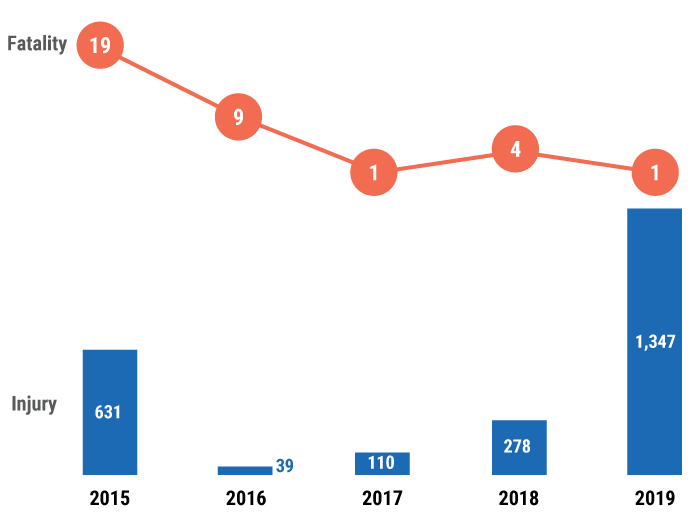
According to the 2018 OCHA survey, almost 90 per cent of the households in the access-restricted area with school-age children reported that their children had faced at least one incident of delay, physical search, harassment or detention on their way to school in the six months preceding the survey. While access to the rest of the H2 schools is easier, many are located in areas regularly patrolled by Israeli forces, resulting in friction between soldiers and students.
During 2019, the Education Cluster recorded 126 disruptions to schooling in H2 involving Israeli forces or settlers, affecting nearly 3,500 students and over 200 staff in 15 schools. This represents a 152 per cent increase compared to the 50 incidents recorded in 2018.
Over half of the disruptions recorded in 2019 (69 incidents) involved Israeli soldiers’ firing tear gas canisters inside or next to schools, following stone-throwing or allegations of stone-throwing by students at Israeli military patrols. These resulted in 1,028 cases of injury, including 934 affecting children and 94 affecting teachers and staff.[7] The remaining 57 disruptions recorded in 2019 involved detention, assault, harassment and/or delay of students en-route to, or from, school.
Sa’ad, 13 years old, lives in the Salaymeh neighborhood of H2 and attends the nearby UNRWA school. He crosses Checkpoint 160 twice a day, on his way to and from school. “I’m not afraid of going to school, but I prefer that my father accompanies me through the checkpoint”, Sa’ad told OCHA. “A few months ago, a soldier stopped me, showed me a photo of a boy throwing stones and claimed it was me. That was not true! He kept me at the checkpoint for about two, hours showing me photos of other children and asking me their names, until my father came and picked me up.” Sa’ad was exposed to tear gas a number of times: “when it happens, I feel that I cannot breathe. My eyes, nose and throat start burning […] I keep smelling the teargas for long afterwards.”
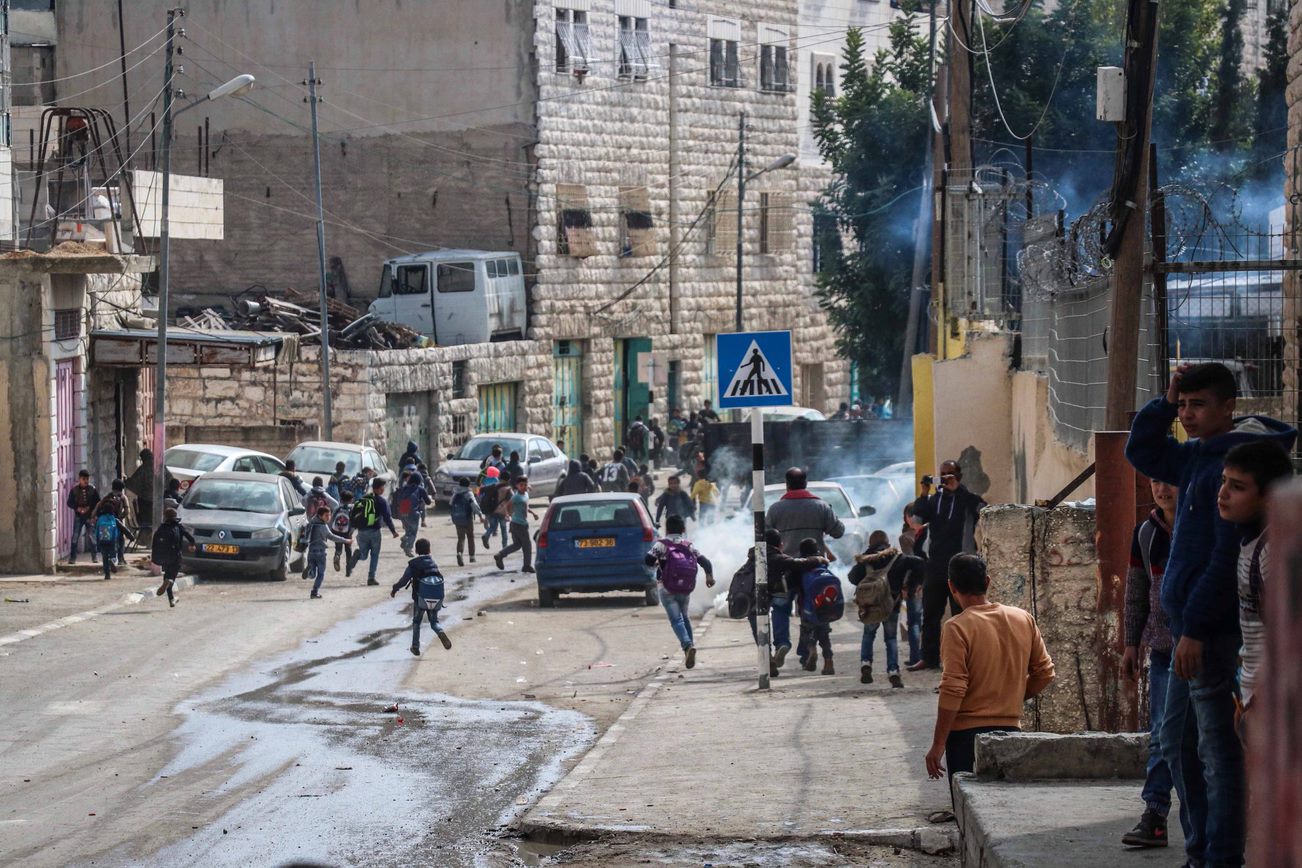
Other clashes
Clashes between Palestinian residents and Israeli forces were also recorded several times a week during 2019, mostly during protests, stone throwing, arrests and other altercations. These incidents resulted in a total of 319 injuries.
Regular hotspots include the area next to the main checkpoint controlling access to Ash Shuhada street, where demonstrations have been held every Friday; the Tareq Bin Ziyad junction, in the vicinity of a school compound; and the Al Harika area, near the Kiryat Arba settlement (see map).
One home in the latter area, belonging to the Da’ana family, was hit with tear gas canisters on at least ten separate occasions during 2019, following stone-throwing and allegations of stone-throwing by Palestinians towards Kiryat Arba settlement’s perimeter fence. One of these incidents, on 24 October, took place while the family was holding a wedding celebration: some 70 people were treated by PRCS paramedics for tear gas inhalation, including 10 children and two elderly people who were evacuated to hospital for further treatment.
Search-and-arrest operations
Friction between Israeli forces and Palestinians living in H2 occurs also during the course of search-and-arrest operations in residents’ homes. According to the OCHA survey, three out of four households in the access-restricted areas have been searched by Israeli forces at least once between October 2015 and date of survey in 2018. In nearly all cases, the family representative reported that the searches involved intimidation and threats. A third reported that a member of the family was physically assaulted during the operation.
“Since 2015, soldiers have been raiding my house twice a month… During one of the raids, they locked us in one room for four hours and didn’t allow anybody to use the bathroom,” said Karim, a 60 years-old man interviewed by OCHA in November 2018.
In 2019, OCHA recorded 70 search-and-arrest operations in H2, marking a slight decline from the 81 operations recorded in 2018. These operations resulted in the arrest of 30 Palestinians, including nine children.
Another 115 Palestinians, including 37 children, were arrested on an ad-hoc basis, mostly at checkpoints or on the streets, including 22 based on allegations of carrying a knife for the purpose of attack.
Fatmeh, 46 years old and mother of four, lives in the Old City of Hebron, next to one of the settlement compounds. Recently,[8] at around four in the morning, a group of about 10 soldiers broke into her house. “That night I was alone with my 12-year-old son. We woke up as the soldiers blew in the main door. They were looking for my other two boys. Luckily, they were with my husband and my daughter at another house we own in Hebron. They blew in with explosives another six doors, searched all the rooms and left after half an hour. They didn’t damage the furniture or take anything. This was the second search in just one month.”
Access restrictions eased but still unpredictable
The restrictions on Palestinian entry to, and exit from, the settlement area of H2 and its surroundings have a pervasive impact on all aspects of life. This is particularly severe for persons with disabilities, the elderly and parents with young children, who often must walk hundreds of metres, and undergo checkpoint searches, before they can leave the area. The fear of harassment at checkpoints has also limited the access of women and girls living in the closed zone to education, work opportunities and health care, compounding negative aspects of traditional gender roles.[9]
These restrictions have been enforced through the deployment of some 120 physical obstacles that separate this area from the rest of the city, including 21 permanently-staffed checkpoints, which restrict the access of people and goods to the area; six of these checkpoints have been fortified with towers, turnstiles, revolving doors and metal detectors, making the crossing more demanding.
During 2019, the Israeli authorities eased some restrictions. In the areas surrounding the closed military zone, a few dozen families have been able to reach their homes by car, following the granting of special permits allowing them to cross certain checkpoints, or following the opening of a gate that blocked access to a street.
Additionally, since May 2019, following a series of protests, the Israeli authorities informed residents of H2 that visitors and other non-residents would be allowed into the closed military zone. In practice, the new policy has been inconsistently implemented: while some people have been allowed through, usually after their IDs are checked and they have passed through a metal detector, in other cases people have been turned back.
“Bringing items such as heavy furniture is challenging”, Firas, a 24 years old resident of the closed area, told OCHA. “Last year I bought a wooden table, chairs and an office desk and, based on the easing announced in May, I hired someone to help me carrying the furniture to my house. At the checkpoint, the soldiers stop the man I hired and told him he is arrested. They gave no reason. After 30 minutes, the man was released and turned back, without explanation. I had to manage with furniture alone.”
As in previous years, the access of Palestinian ambulances and fire brigades to the access-restricted areas of H2 required prior coordination with the Israeli military. Regarding ambulances, liaison with the Israeli authorities is conducted by the International Committee of the Red Cross (ICRC), and fire brigades by the Hebron municipality.
Despite these coordination mechanisms, delays at checkpoints have continued. On 5 March 2019, a fire brigade unit, which was sent to respond to a fire in a home in the As Salaymeh neighborhood of H2, was delayed at a checkpoint for between 10 and 20 minutes; three children aged one, two and four lost their lives in the fire.[10]
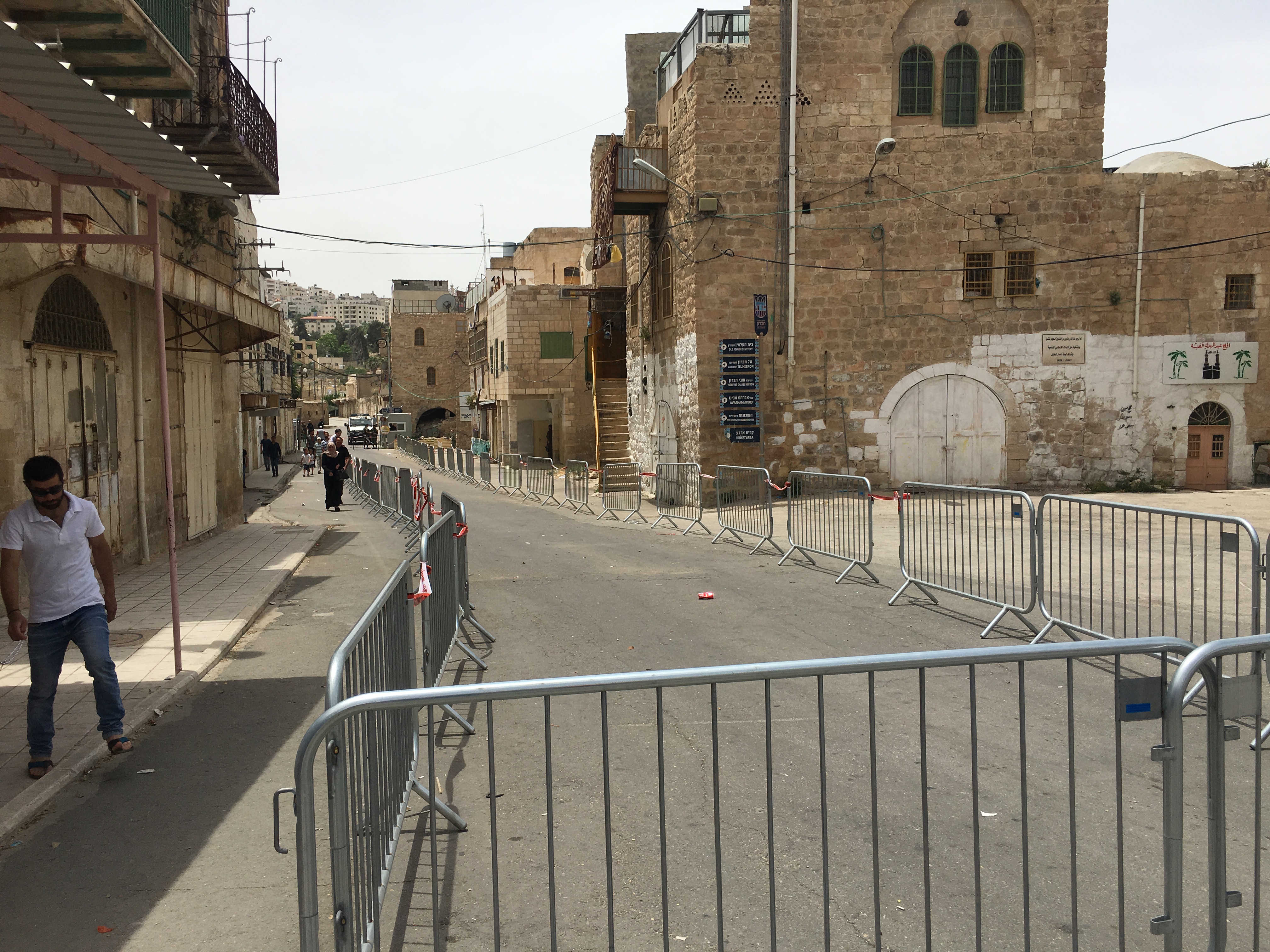
Concern over forcible transfer
The coercive environment prevailing in the H2 area of Hebron over the past two decades has left many Palestinians with no other choice than to leave their homes, raising concerns of forcible transfer, which is a grave breach of the Fourth Geneva Convention.
According to OHCHR, between October 2018 and August 2019, at least six Palestinian families moved from the Tel Rumeida area of H2, owing to coercive factors. Long-standing movement restrictions and, above all, fear for the safety of their children, were listed by families as reasons for leaving H2.[11]
A survey conducted in 2015 in the access-restricted areas found that almost a third of the housing units in the area were empty.[12] Following incentives by the Palestinians authorities, including various subsidies and exemptions, some of these abandoned homes have been re-inhabited by Palestinians, but many more remain empty, generating a ‘ghost town’ atmosphere.
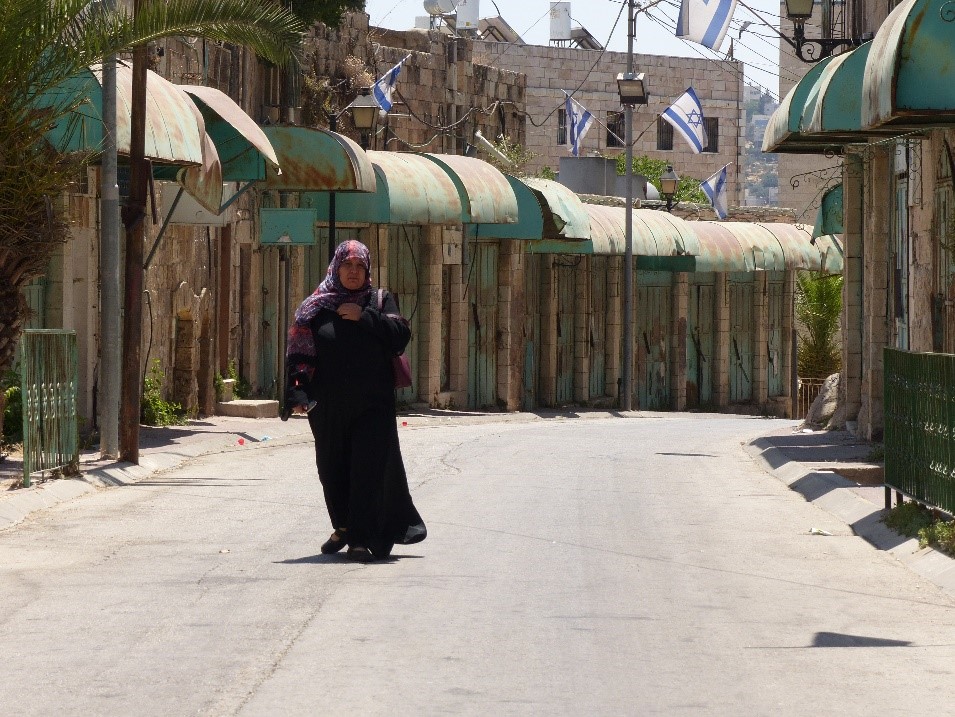
Humanitarian response
Humanitarian and human rights partners have stepped up their response through a comprehensive, multi-sectoral action plan targeting 17,500 vulnerable Palestinians in H2. The plan, which has been facilitated by the West Bank ‘Inter-cluster Coordination Group’, includes a package of interventions for a total estimated value of US$ 7.09 million. These interventions rely on information collected in the 2018 OCHA Household Survey and are part of the oPt 2020 Humanitarian Response Plan (HRP).
The objectives of the plan are aligned with those identified for the entire HRP, namely, ensuring that: the rights of Palestinians living in H2 are protected, respected and promoted; basic needs are met through the provision of quality basic services and improved access to resources; and the capacity of vulnerable families and individuals to cope with, and overcome, the protracted crisis, is supported, while solutions to violations and other root causes of threats and shocks are pursued.
The plan includes activities such as monitoring and documentation of violations and conflict related violence, legal counselling, psychosocial support, rehabilitation services and first aid training. Education activities will also include nutrition in schools for children in the first four grades, which complement an ongoing project that focus on improving the nutritional status of school-age girls in first four grades. The Food assistance to the poor will be provided through emergency cash assistance using electronic vouchers, alongside emergency support through agriculture-based interventions.
The action plan will be supplemented by a range of coordinated advocacy activities, including public advocacy and media outreach, along with private diplomacy and engagement with various local authorities and member states.
Of note, while these interventions can mitigate the impacts of policies and practices affecting Palestinians in H2, any meaningful improvement in the humanitarian situation will require structural changes, including the lifting of access restrictions and the enforcement of the rule of law on violent settlers.
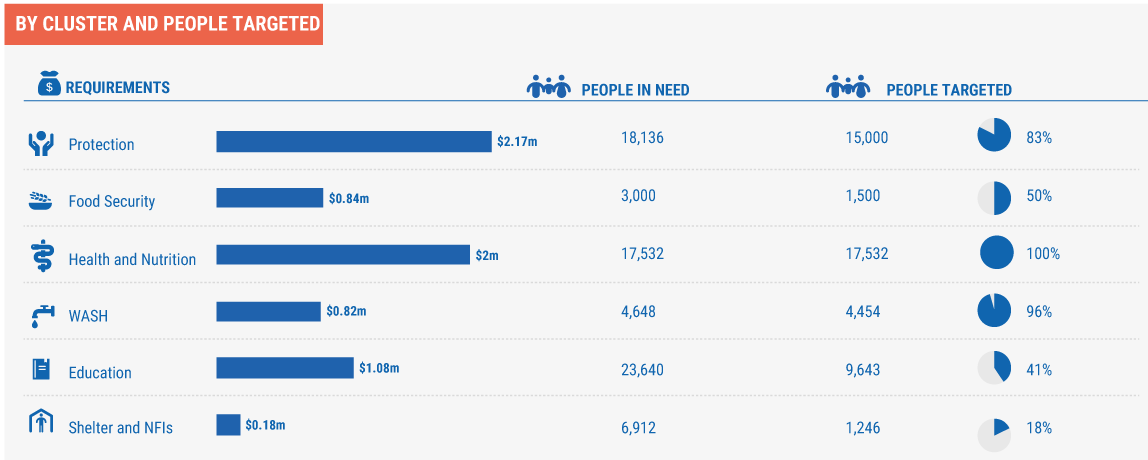
Hebron settlements: legal and other developments
On 30 June 2019, the Israeli Supreme Court rejected a petition challenging the operation of a new municipal entity encompassing the H2 settlements, which was created by a military order issued in 2017. In addition to upgrading the provision of services to the settlements under its jurisdiction, this new body has the power to purchase property and expand settlements in the area. In December 2019, the Ministry of Defense announced that it would advance the construction of a new settlement in the wholesale market complex in H2.[13]
Additionally, on 25 August 2019, settlers re-occupied part of the Abu Rajab building located in the closed area of H2, from which they had been evacuated following a court ruling in 2018. Since then, a Palestinian family living in the other part of the building has been subjected to repeated harassment and violence by settlers. On 23 December, infrastructure work aimed at connecting the building to the water grid commenced. A legal case on the ownership of the building is still pending with an Israeli court. Also, on 23 December 2019, the Jerusalem District Court upheld a ruling by a lower court to evacuate Israeli settlers from another home in the closed area of H2, which they had taken over. The court ordered that the ruling must be enforced within 45 days.
[1] All the names of people cited in this article were changed to protect their identity.
[2] The closed area encompasses primarily the Tel Rumeida quarter and the Ash-Shuhada street. The military order was issued on 1 November 2015 and was renewed periodically until 15 May 2016. The order does not appear to have been renewed since that date, although restrictions remain in place in practice.
[3] These figures exclude incidents that did not result in casualties or damage, such as intimidation, trespass and access denial, all of which are believed to occur more frequently.
[4] On 27 November 2019, the UN Office of the High Commissioner of Human Rights (OHCHR) issued a statement expressing concern about this wave of violence.
[5] Figures throughout the article include incidents that took place in the areas next to the H2 checkpoints, some of which are partially in H1.
[6] These are Al Fayha primary school, Ibrahimiyye primary school, and Qurdoba primary school.
[7] Some of children and staff were injured on more than one occasion.
[8] Exact date withheld.
[9] Report of the United Nations High Commissioner for Human Rights, “Israeli settlements in the Occupied Palestinian Territory, including East Jerusalem, and in the occupied Syrian Golan”, A/HRC/43/67, March 2020, para. 51.
[10] In response to a letter sent by the Association for Civil Rights in Israel, the IDF Central Command wrote that due to a miscommunication, the soldiers staffing the checkpoint were not notified about the incident, resulting in the delay of the fire brigade. Following the incident, according to the letter, operating procedures were updated and instructions improved.
[11] Report of the United Nations High Commissioner for Human Rights, “Israeli settlements in the Occupied Palestinian Territory, including East Jerusalem, and in the occupied Syrian Golan”, A/HRC/43/67, March 2020, para. 53.
[12] The survey was conducted by the Hebron Rehabilitation Committee, as part of a preservation and revitalization plan. According to its findings, 1,079 of the of 3,369 housing units surveyed in what it defines as Hebron’s Old City were found to be empty.
[13] The Wholesale Market has been closed since 1994. The site was owned by Jewish families under the Ottoman Empire, managed by the Jordanian Government after 1948, then leased to the Palestinian Hebron Municipality and used by Palestinian traders.









